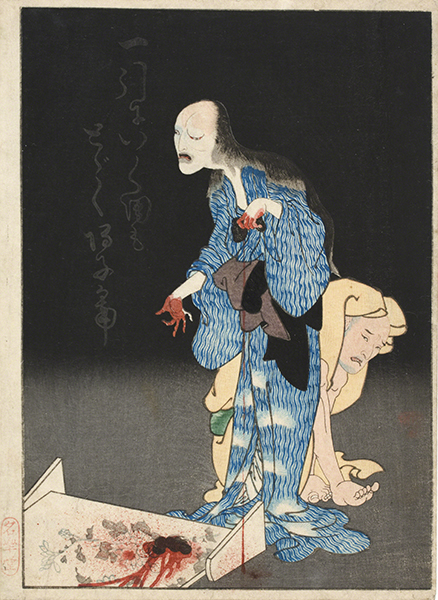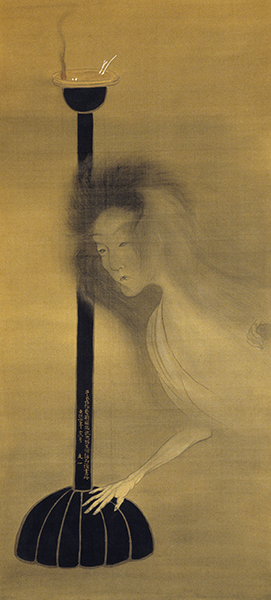Ghosts for Halloween
Ghosts, a big part of Halloween, are elements of mystery and curiosity in many cultures. There are great differences in the ways ghosts are perceived around the world, from abject terror to sympathy to communication from beyond the grave. In Japan, there are a number of interesting examples of ghosts and ghost stories in art of the Edo Period (1615–1868), a time when the arts, particularly theater, painting, and printmaking, flourished.
 |
| Gosōtei Hirosada (ca. 1810–1864, Japan), Ichikawa Sukejūrō II (?) as Takuetsu and Okawa Hashizō as Oiwa in the play Ghost Story of Yatsuya (Yotsuya Kaidan), ca. 1847–1853. Color woodcut print on paper, 9 ¾" x 7" (24.8 x 17.8 cm). © 2022 Philadelphia Museum of Art. (PMA-5419) |
Ghost stories were very popular in Kabuki theater, a favorite subject of ukiyo-e artists. These artists concocted all sorts of horrific afflictions for the characters they portrayed. This grisly scene from the first act of Ghost Story of Yatsuya depicts the put-upon beauty Oiwa and the brothel owner Takuetsu. Covered in boils after being doused with poison, Oiwa accidentally inflicts mortal wounds upon herself while trying to prevent Takuetsu from betraying her to her husband Iemon. Her husband had hired Takuetsu to ruin Oiwa’s reputation in order to justify killing her. After her death, Oiwa returns as a ghost to drive Iemon mad.
The actor portraying Takuetsu, Ichikawa Sukejuro II, was active in Osaka in the 1830s and 1840s. He was a renowned actor of tachikayu (young heroic male roles) in Osaka, Kyoto, and Kobe. Okawa Hashizō (1784–1849), who played Oiwa, had a prolific stage career from 1803 to 1848. His first role as Oiwa was in 1825, more than 20 years before this woodcut was created.
The ukiyo-e genre of multiple woodblock color prints evolved during the Edo Period in Japan. It was 200-year period of peace and prosperity as Japan was isolated from the outside world. The goods and services provided to the ruling classes enriched the merchant class, a social group considered lower than farmers and artists. They spent their newfound wealth on the entertainments of the pleasure quarters in Japanese cities. One of these pleasures was the Kabuki theater.
Ukiyo-e means “pictures of the floating world” in the Buddhist sense of the transience of physical pleasures. Although often associated with Edo (Tokyo), most Japanese cities had pleasure quarters, and these districts generated an interest in the print medium. Ukiyo-e theater prints were mementos of a favorite actor, play, or scene. They were also used as advertisements for Kabuki theaters.
Osaka was a harbor city halfway between Kyoto (the seat of the emperor) and Edo (the seat of the military dictator, or shogun). Although the Osaka ukiyo-e art community was much smaller than Edo, it was just as lively and produced some extraordinary artists, such as Gosōtei Hirosada. Like most of the ukiyo-e school artists in Osaka, Gosōtei's body of work dealt entirely with theater subjects.
Gosōtei was the most important and prolific of the Osaka artists. He pioneered many novel diptych and triptych compositions, often experimenting with focal points for actors in the same scene. Gosōtei's actor portraits exhibit all of the standard aesthetic requirements for ukiyo-e theater scenes—beautifully rendered patterns, bold use of contour line, and showing a character’s most dramatic moment.
 |
| Tani Bun’ichi (1797–1818, Japan), Ghost and Oil Lamp. Ink, color, and gold leaf on silk, hanging scroll, 43" x 19 ¼" (109.2 x 48.9 cm). The Cleveland Museum of Art, Kelvin Smith Fund 1992.71. (8S-30086) |
Tani Bun'ichi’s teacher, artist Tani Bunchō (1763–1841), was a Nanga ("Southern style") painter. This traditional Japanese style was influenced by monochromatic amateur/scholar paintings from China. The majority of Bun'ichi's works are landscapes and nature paintings in monochromatic ink.
Ghost and Oil Lamp, which portrays a ghost next to a lacquered lamp stand, was quite a departure from Bun'ichi’s typical subject matter. Although he created multiple versions of the work, Bun’ichi stated he did not like painting ghosts. This work may have been influenced by Bun’ichi’s acquaintance Sanyutei Encho (1839–1900), a famous storyteller known for kaidan (ghost and horror stories) who collected ghost paintings.


Comments